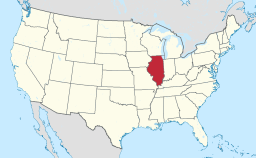Lyons, Illinois
| Lyons | |
| Village of Lyons | |
| Village | |
| Official name: Christopher Getty Mayor | |
| Motto: Gateway to the West | |
| Country | United States |
|---|---|
| State | Illinois |
| County | Cook |
| Coordinates | 41°48′48″N 87°49′19″W / 41.81333°N 87.82194°WCoordinates: 41°48′48″N 87°49′19″W / 41.81333°N 87.82194°W |
| Area | 2.24 sq mi (6 km2) |
| - land | 2.18 sq mi (6 km2) |
| - water | 0.06 sq mi (0 km2) |
| Population | 10,729 (2010) |
| - urban | 4,789.7 |
| Timezone | CST (UTC-6) |
| - summer (DST) | CDT (UTC-5) |
| Postal code | 60534 |
| Area code | 708 |
|
Location in Cook County and the state of Illinois.
|
|
|
Location of Illinois in the United States
|
|
Lyons (also known as Lyons Township) is a village in Lyons Township Cook County, Illinois, United States. The population was 10,729 at the 2010 census. The Chicago Portage National Historic Site is located in Lyons.
Although first settled in 1888, Lyons remained as a large unincorporated area of Cook County for several years, before becoming a census-designated place in 2009. The community is greatly steeped in earlier historical roots. In 1673 French Explorer Louis Joliet and Jesuit missionary Father Pierre Marquette left Green Bay, Wisconsin, by canoe in search of a western passage to the Pacific. As they traveled into the Spanish controlled area of Louisiana, they realized that the mighty Mississippi River drained into the already well known Gulf of Mexico. With winter approaching, they headed north as quickly as possible. To save time, the Potawatomi Indians who were with them encouraged changing their route to the Illinois River. The short cut led to the Des Plaines River and caused the French travelers to discover “Le Portage.” This half-mile wide area of land connecting the Chicago River and the Des Plaines River, over which they could carry their canoes and supplies, was to become the discovery for which they would both become famous. Later known as the Chicago Portage, this small area became the “Gateway to the West” and was used by thousands of early settlers and traders traveling both east and west. The discovery of “Le Portage” was part of the impetus that led to Chicago becoming a center for the world trade.
Louis Joliet conceived the idea of constructing a canal to connect the two waterways. This idea was to become a reality 200 years later with the opening of the Illinois and Michigan Canal. In time, the part of the I&M Canal that connected the south branch of the Chicago River with the Des Plaines River was replaced with the Chicago Sanitary and Ship Canal, which was completed in 1900. Today, a statue stands in Lyons at the Chicago Portage National Historic Sight just north of Interstate 55 along Harlem Avenue, commemorating this historic National Heritage Corridor which stretches southwest thru La Salle, Illinois.
...
Wikipedia


